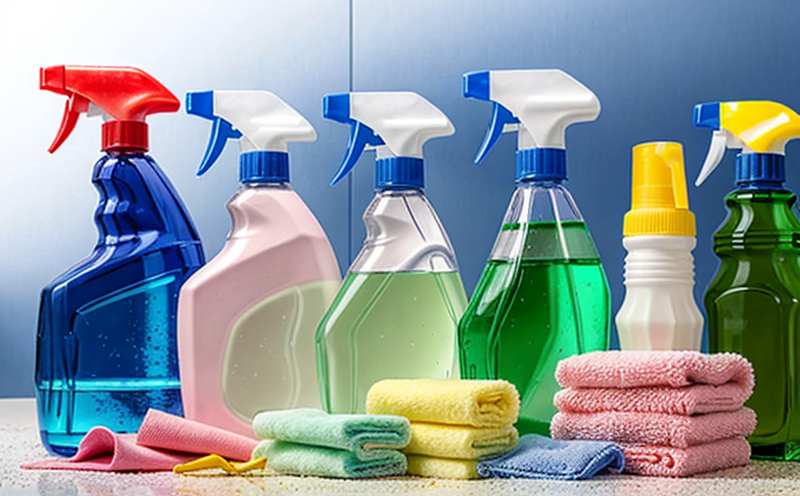Corrosion Testing on Metal Surfaces by Cleaning Products
In today's fast-paced consumer goods market, ensuring that cleaning products and detergents do not cause harm to metal surfaces is crucial. This testing ensures product safety, compliance with regulations, and the protection of consumers' belongings. Corrosion testing assesses how cleaning agents interact with different types of metals under various conditions to prevent potential damage.
Understanding the chemistry behind corrosion is vital for this testing. Metals can corrode due to reactions between their surface and an electrolyte solution (often found in detergents). This reaction generates heat, which can further accelerate degradation. The goal of this testing is to identify any conditions under which metal surfaces may be vulnerable.
Testing involves exposing metal samples to cleaning products for specified durations and temperatures. Specimen preparation typically includes cleaning the metal surface thoroughly before immersion in the detergent solution. Following exposure, analysts examine the sample closely for signs of pitting, discoloration, or other forms of corrosion. The extent and nature of any observed damage will determine whether the product meets safety standards.
For accurate results, laboratories must adhere to rigorous protocols outlined by relevant international standards such as ISO 14612:2017 for accelerated corrosion tests on metallic materials using chemical cleaning agents. By following these guidelines, testing can be standardized across industries and laboratories worldwide.
This process helps manufacturers develop safer products while ensuring they comply with local regulations and industry best practices. It also protects consumers by reducing the risk of accidental damage to their belongings during routine cleaning tasks. Regular corrosion assessments form an integral part of a company's quality assurance program, helping maintain high standards throughout production processes.
The importance of this testing cannot be overstated given its role in safeguarding both consumer goods and industrial equipment from unnecessary wear and tear. As technology advances, so too do the methods employed to conduct these tests more efficiently and accurately than ever before.
Applied Standards
When conducting corrosion testing on metal surfaces by cleaning products, laboratories follow several key international standards that provide a framework for accurate and consistent results. These include:
- ISO 14612:2017 - This standard specifies the procedure for accelerated corrosion tests using chemical cleaning agents on metallic materials.
- ASTM G58-13 - Developed by ASTM International, this guide covers procedures for determining the resistance of metal coatings to corrosive media such as household detergents and solvents.
Compliance with these standards ensures that all testing conducted is up-to-date and aligned with global industry best practices. This consistency allows companies to confidently rely on test results when making decisions about their product formulations or design changes aimed at enhancing durability.
Scope and Methodology
The scope of this service includes evaluating the impact of cleaning products on various types of metal surfaces, including but not limited to stainless steel, aluminum, brass, copper, and galvanized iron. The methodology involves several steps:
- Preparation: Thoroughly clean each metal sample before placing it into a standardized solution containing the cleaning product.
- Exposure: Submerge the prepared samples in the detergent for specified durations at controlled temperatures.
- Evaluation: Inspect and document any changes observed on the surface of the metals after exposure. This includes noting any signs of pitting, discoloration, or other forms of corrosion.
- Reporting: Compile detailed reports highlighting findings from each test run, along with recommendations for potential improvements or adjustments to product formulations based on these results.
The scope encompasses not just laboratory testing but also providing expert advice regarding best practices in formulation and packaging aimed at minimizing the risk of metal corrosion. This holistic approach ensures that clients receive comprehensive support throughout their product development lifecycle.
Environmental and Sustainability Contributions
- Promoting Sustainable Product Development: By identifying potential issues early in the design stage, this testing helps manufacturers create more sustainable products that last longer without compromising on performance.
- Reducing waste: With increased durability comes less frequent replacement needs, leading to lower overall environmental impact associated with manufacturing and disposal activities.
- Incorporating eco-friendly ingredients: Understanding the effects of different components allows for better selection of environmentally friendly alternatives without sacrificing effectiveness.
- Enhancing Consumer Awareness: Educating consumers about proper storage and usage practices can extend product life, thereby reducing waste and encouraging responsible consumption habits.





